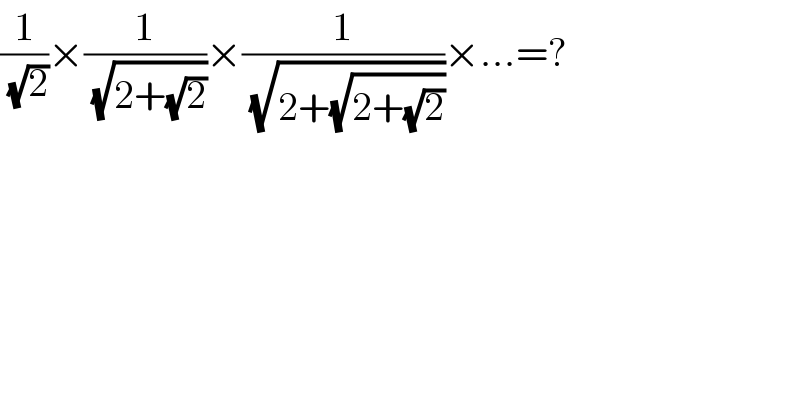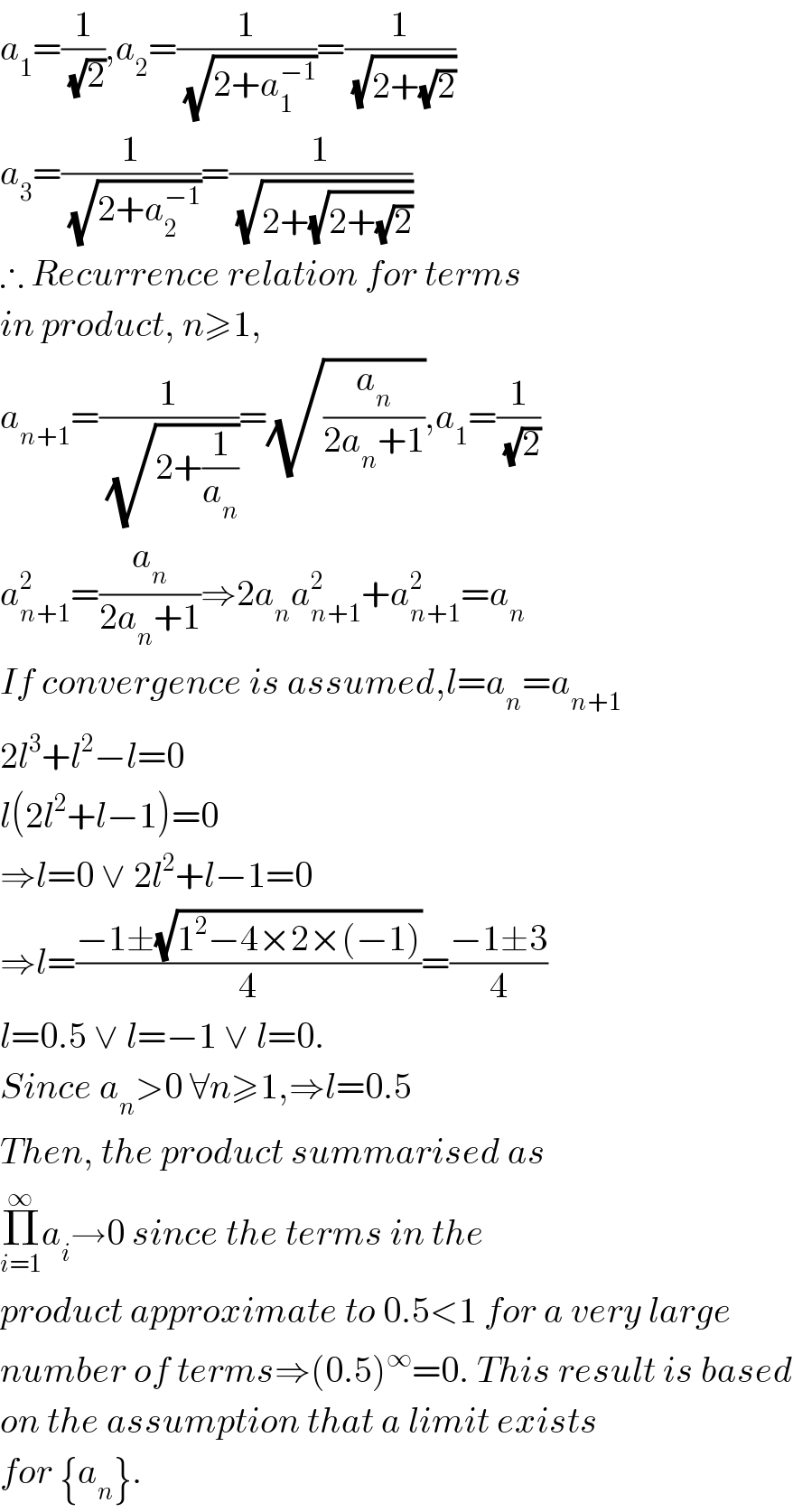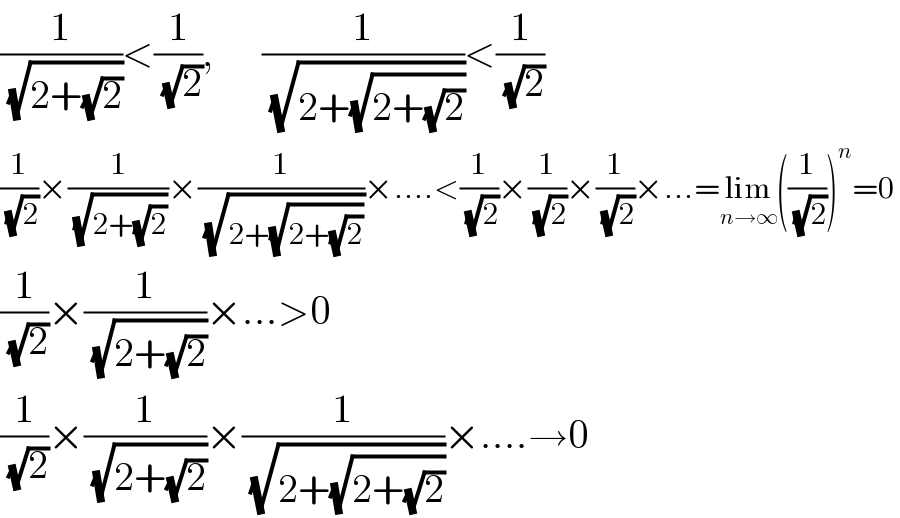
Question Number 2326 by Filup last updated on 16/Nov/15

$$\frac{\mathrm{1}}{\sqrt{\mathrm{2}}}×\frac{\mathrm{1}}{\sqrt{\mathrm{2}+\sqrt{\mathrm{2}}}}×\frac{\mathrm{1}}{\sqrt{\mathrm{2}+\sqrt{\mathrm{2}+\sqrt{\mathrm{2}}}}}×...=? \\ $$
Commented by Rasheed Soomro last updated on 16/Nov/15

$$\mathcal{N}{ice}\:\mathcal{A}{pproach}! \\ $$
Commented by Yozzi last updated on 16/Nov/15

$${a}_{\mathrm{1}} =\frac{\mathrm{1}}{\sqrt{\mathrm{2}}},{a}_{\mathrm{2}} =\frac{\mathrm{1}}{\sqrt{\mathrm{2}+{a}_{\mathrm{1}} ^{−\mathrm{1}} }}=\frac{\mathrm{1}}{\sqrt{\mathrm{2}+\sqrt{\mathrm{2}}}} \\ $$$${a}_{\mathrm{3}} =\frac{\mathrm{1}}{\sqrt{\mathrm{2}+{a}_{\mathrm{2}} ^{−\mathrm{1}} }}=\frac{\mathrm{1}}{\sqrt{\mathrm{2}+\sqrt{\mathrm{2}+\sqrt{\mathrm{2}}}}} \\ $$$$\therefore\:{Recurrence}\:{relation}\:{for}\:{terms}\: \\ $$$${in}\:{product},\:{n}\geqslant\mathrm{1}, \\ $$$${a}_{{n}+\mathrm{1}} =\frac{\mathrm{1}}{\sqrt{\mathrm{2}+\frac{\mathrm{1}}{{a}_{{n}} }}}=\sqrt{\frac{{a}_{{n}} }{\mathrm{2}{a}_{{n}} +\mathrm{1}}},{a}_{\mathrm{1}} =\frac{\mathrm{1}}{\sqrt{\mathrm{2}}} \\ $$$${a}_{{n}+\mathrm{1}} ^{\mathrm{2}} =\frac{{a}_{{n}} }{\mathrm{2}{a}_{{n}} +\mathrm{1}}\Rightarrow\mathrm{2}{a}_{{n}} {a}_{{n}+\mathrm{1}} ^{\mathrm{2}} +{a}_{{n}+\mathrm{1}} ^{\mathrm{2}} ={a}_{{n}} \\ $$$${If}\:{convergence}\:{is}\:{assumed},{l}={a}_{{n}} ={a}_{{n}+\mathrm{1}} \\ $$$$\mathrm{2}{l}^{\mathrm{3}} +{l}^{\mathrm{2}} −{l}=\mathrm{0} \\ $$$${l}\left(\mathrm{2}{l}^{\mathrm{2}} +{l}−\mathrm{1}\right)=\mathrm{0} \\ $$$$\Rightarrow{l}=\mathrm{0}\:\vee\:\mathrm{2}{l}^{\mathrm{2}} +{l}−\mathrm{1}=\mathrm{0} \\ $$$$\Rightarrow{l}=\frac{−\mathrm{1}\pm\sqrt{\mathrm{1}^{\mathrm{2}} −\mathrm{4}×\mathrm{2}×\left(−\mathrm{1}\right)}}{\mathrm{4}}=\frac{−\mathrm{1}\pm\mathrm{3}}{\mathrm{4}} \\ $$$${l}=\mathrm{0}.\mathrm{5}\:\vee\:{l}=−\mathrm{1}\:\vee\:{l}=\mathrm{0}. \\ $$$${Since}\:{a}_{{n}} >\mathrm{0}\:\forall{n}\geqslant\mathrm{1},\Rightarrow{l}=\mathrm{0}.\mathrm{5} \\ $$$${Then},\:{the}\:{product}\:{summarised}\:{as} \\ $$$$\underset{{i}=\mathrm{1}} {\overset{\infty} {\prod}}{a}_{{i}} \rightarrow\mathrm{0}\:{since}\:{the}\:{terms}\:{in}\:{the}\: \\ $$$${product}\:{approximate}\:{to}\:\mathrm{0}.\mathrm{5}<\mathrm{1}\:{for}\:{a}\:{very}\:{large}\: \\ $$$${number}\:{of}\:{terms}\Rightarrow\left(\mathrm{0}.\mathrm{5}\right)^{\infty} =\mathrm{0}.\:{This}\:{result}\:{is}\:{based} \\ $$$${on}\:{the}\:{assumption}\:{that}\:{a}\:{limit}\:{exists} \\ $$$${for}\:\left\{{a}_{{n}} \right\}. \\ $$
Answered by prakash jain last updated on 16/Nov/15

$$\frac{\mathrm{1}}{\sqrt{\mathrm{2}+\sqrt{\mathrm{2}}}}<\frac{\mathrm{1}}{\sqrt{\mathrm{2}}},\:\:\:\:\:\:\frac{\mathrm{1}}{\sqrt{\mathrm{2}+\sqrt{\mathrm{2}+\sqrt{\mathrm{2}}}}}<\frac{\mathrm{1}}{\sqrt{\mathrm{2}}} \\ $$$$\frac{\mathrm{1}}{\sqrt{\mathrm{2}}}×\frac{\mathrm{1}}{\sqrt{\mathrm{2}+\sqrt{\mathrm{2}}}}×\frac{\mathrm{1}}{\sqrt{\mathrm{2}+\sqrt{\mathrm{2}+\sqrt{\mathrm{2}}}}}×....<\frac{\mathrm{1}}{\sqrt{\mathrm{2}}}×\frac{\mathrm{1}}{\sqrt{\mathrm{2}}}×\frac{\mathrm{1}}{\sqrt{\mathrm{2}}}×...=\underset{{n}\rightarrow\infty} {\mathrm{lim}}\left(\frac{\mathrm{1}}{\sqrt{\mathrm{2}}}\right)^{{n}} =\mathrm{0} \\ $$$$\frac{\mathrm{1}}{\sqrt{\mathrm{2}}}×\frac{\mathrm{1}}{\sqrt{\mathrm{2}+\sqrt{\mathrm{2}}}}×...>\mathrm{0} \\ $$$$\frac{\mathrm{1}}{\sqrt{\mathrm{2}}}×\frac{\mathrm{1}}{\sqrt{\mathrm{2}+\sqrt{\mathrm{2}}}}×\frac{\mathrm{1}}{\sqrt{\mathrm{2}+\sqrt{\mathrm{2}+\sqrt{\mathrm{2}}}}}×....\rightarrow\mathrm{0} \\ $$
